The Mac Pro Review (Late 2013)
by Anand Lal Shimpi on December 31, 2013 3:18 PM ESTSSD
The new Mac Pro does the right thing and abandons internal hard drives in favor of high-speed PCIe based storage. You could argue wanting more internal PCIe storage, but hard drives don’t belong inside this machine - for that there’s Thunderbolt 2.
There’s a single proprietary Apple PCIe SSD connector and module inside the new Mac Pro. The connector looks similar to what’s in the new MacBook Pro but I haven’t verified compatibility. Unlike the new MacBook Pros, the Mac Pro SSDs only ship in a x4 PCIe configuration. The result is faster peak sequential speeds.
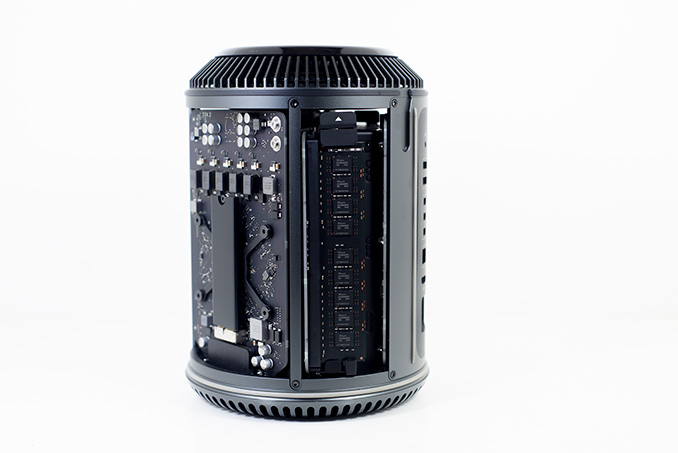
Custom SSD behind the GPU board on the left
My review sample had a 512GB Samsung XP941 based drive. I believe this is a 2-bit-per-cell MLC design with a 512MB LPDDR2-1066 DRAM. Samsung’s SSD architectures have evolved pretty well over the years. As long as you’re careful not to completely fill the drive you should be ok from an IO consistency standpoint as well. I continue to recommend keeping around 15 - 20% of the SSD free if you want to keep performance at a relatively high level. Definitely keep this in mind if you’re torn about what capacity drive you should outfit your system with.
| Mac Pro (Late 2013) SSD Options | ||||||
| 4-Core Config | 6-Core Config | |||||
| 256GB | Included | Included | ||||
| 512GB | +$300 | +$300 | ||||
| 1TB | +$800 | +$800 | ||||
Apple offers three SSD capacities with the new Mac Pro: 256GB, 512GB and 1TB. Both default configurations come with a 256GB drive. Upgrades to 512GB/1TB cost the same regardless of your starting point: $300 and $800, respectively. Chances are you’re going to depend fairly heavily on external storage for media, which leaves you the flexibility of sticking with the base 256GB configuration. Personally I’d use the Mac Pro just as much as a regular PC (including gaming) as I would for photo/video work, so I’d push for the highest capacity SSD possible. Since Apple isn’t using a standard connector or form factor here, you can’t necessarily count on anyone offering a decent aftermarket solutions (although OWC has done so in the past). If OWC or anyone else was brave enough to produce an aftermarket Mac Pro SSD, it might come with fewer tradeoffs compared to what we’ve seen in the portable Mac space. I’m primarily talking about ultra low idle power not being as much of an issue for an SSD in the Mac Pro. Last time I looked, OWC’s aftermarket MacBook Air/Pro SSDs consumed more power at idle compared to the Apple OEM drives. The same issues wouldn’t matter in a Mac Pro.
I ran the 512GB SSD through our standard four-corners Iometer test suite. The numbers were expectedly a bit higher than what I measured on the 15-inch Haswell rMBP and the 21.5-inch Haswell iMac thanks to the drive’s PCIe x4 interface. Random write performance takes a step backwards but all of the results we're showing here are more than enough for single user workstation use. Although Mavericks itself seems to have issues that can cause high latency IO (particularly around quicklook), the SSD in the Mac Pro performed quite well.
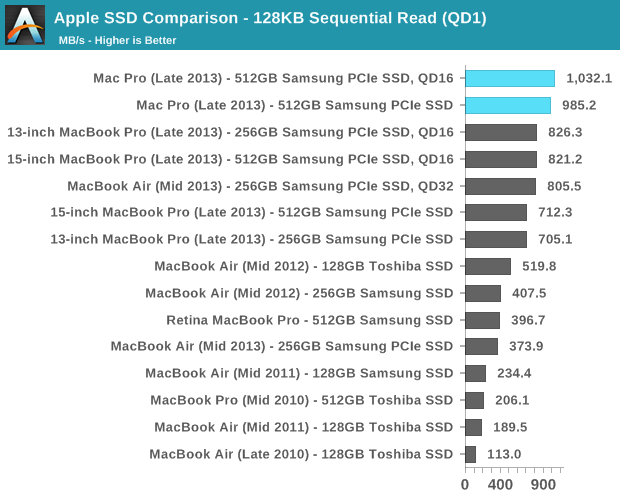
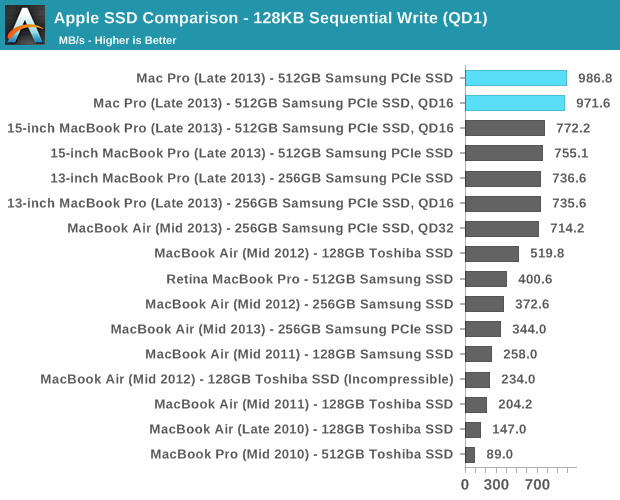
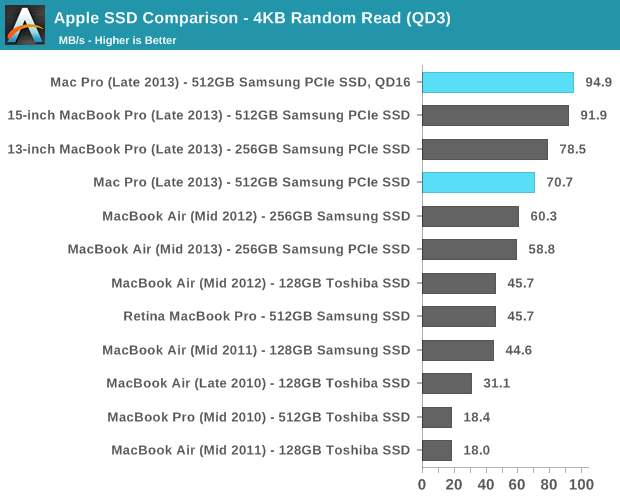
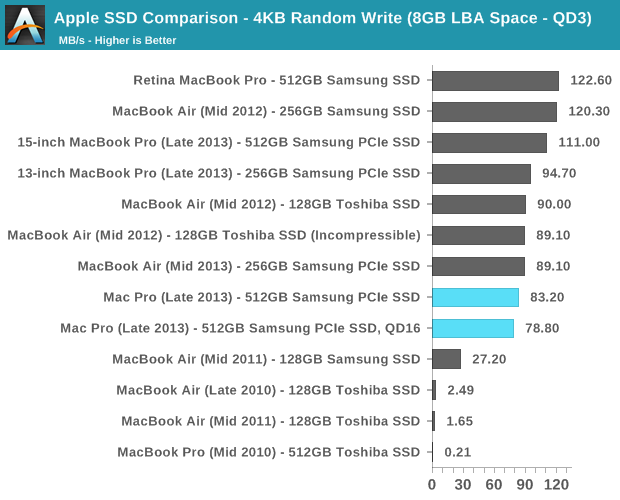
I’m beyond pleased to see that Apple has moved its Mac lineup virtually top to bottom to PCIe SSDs. This is absolutely the right approach, and one that all other OEMs should follow.
Gigabit Ethernet & WiFi
Broadcom won all of the networking sockets in the new Mac Pro. Each machine ships with two BCM57762 Gigabit Ethernet controllers and a BCM4360 802.11ac controller. Each controller is connected to its own PCIe 2.0 x1 lane, guaranteeing it more than enough bandwidth to operate at full speed. The GigE ports on the back of the Mac Pro are thus independent and can sustain full bandwidth in tandem.
The 802.11ac solution is the same 3-stream BCM4360 you’ll find in the new Haswell MacBook Pros. The Broadcom controller supports 80MHz wide channels and 256 QAM, resulting in a peak theoretical data rate of 433Mbps per stream. With three streams that works out to be a max negotiated PHY rate of 1.3Gbps.
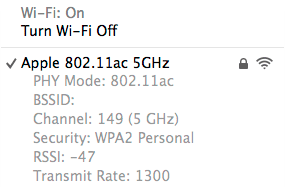
In practice I found the Mac Pro’s WiFi performance in best conditions to be similar to that of the 21.5-inch 2013 iMac, which ships with the same hardware. Over UDP that amounts to just under 900Mbps, and a bit over 600Mbps over TCP. You’re still better off using GigE if you can, but 3-stream 802.11ac is arguably good enough if you can’t get a cable down to your Mac.
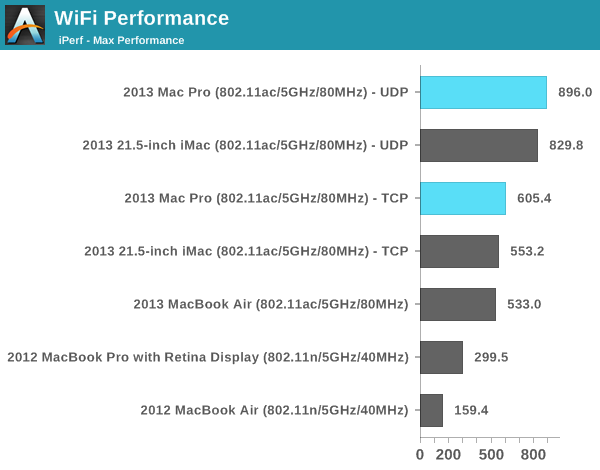











267 Comments
View All Comments
JlHADJOE - Wednesday, January 1, 2014 - link
AFAIK the D700 is also a FirePro, and also has ECC on its VRAM.tipoo - Wednesday, January 1, 2014 - link
Wrong, it has no ECC. On OSX Apple writes much of the graphics driver anyways, so they can get away with calling Radeons FirePros as ECC isn't a necessity to call them that.Kevin G - Wednesday, January 1, 2014 - link
ECC on the FirePro's doesn't actually add additional RAM like it does on traditional server DIMM's. Instead as RAID5 like parity is performed on GPU memory channels to be able to be able to detect a memory error. Thus the 6 GB card will only have 5.25 GB available to use with ECC enabled. Since all the memory channel have to be used for a memory access, performance in some workloads takes a significant hit. I believe by default ECC is disabled for performance and memory capacity reasons.There is also one other difference between the D700 and the W9000: clock speeds and voltages. The D700 runs are a lower clock speed by default and presumably lower voltage to cut power consumption.
DaveGirard - Wednesday, January 1, 2014 - link
the D700 is clocked lower than the W9000. It's at 850MHz instead of 950.lilo777 - Wednesday, January 1, 2014 - link
Except it does not have ECC memory or the Pro drivers which are the only things that differentiate Pro from consumer grade cards. As such they are consumers grade cards (and the two year old generation) which cost around $700 at most not the $3500 pro cards.japtor - Wednesday, January 1, 2014 - link
There's never been a pro driver distinction in OS X, Radeons are validated for pro apps in OS X like FirePros in Windows. Granted there hasn't been the pro branding until now, but Apple does the drivers iirc so I don't see them bothering with splitting the driver base like AMD does.melgross - Wednesday, January 1, 2014 - link
You know nothing about Apple's drivers. I would bet that at the very least, they are based on the pro driver configurations, as apple has little interest in gaming, and a lot of interest in pro users. If you look at the performance of this in a pro app you can see that performance is pretty good. Mac Pro's are used in NASA, drug company research labs, CAD shops, video, photography labs and studios and publishing. Game drivers are of no interest to them.solipsism - Tuesday, December 31, 2013 - link
Note that he speculates that the CPU would be soldered (something no Mac Pro has ever had) and the thermal cap removed (something I believe Apple had only done once).Also note he doesn't have any more PCIe available for the SSD so he ends up going with the much slower SATA version but to make up some of the speed he gets 2x512GB in a RAID 0 configuration.
I like the case they used and I'm expect to see *more* of these smaller cases hit the market for DIYer and from OEMs now that Apple has stepped in.
Lonyo - Wednesday, January 1, 2014 - link
There are lots of small cases on the market and there have been for a while now... sure there could be more, but they are already widely available with a hell of a lot of variety of designs... not sure exactly how you think Apple will have any real impact on this market.If anything is going to have an impact it would be Steam boxes because OEMs might start pulling their fingers out and designing more gaming oriented small boxes, although they also are already rather common, but not always available for end users, such as the Alienware system which has a horizontal GPU mount with a riser.
solipsism - Wednesday, January 1, 2014 - link
Where are all these OEM PCs with very small cases but high performance like the new Mac Pro?